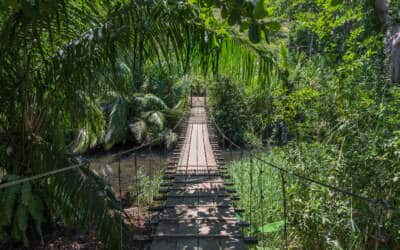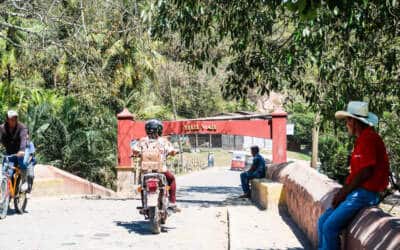
Dreaming about traveling Central America?
Central America is a corridor of vibrant cultures and dramatic landscapes, where mist-shrouded cloud forests give way to smoking volcanoes, colonial plazas sit beside sun-soaked beaches, and centuries-old indigenous traditions thrive alongside modern eco-adventures. Here on Unique Universe’s Central America hub, you’ll find practical, firsthand insights drawn from my travels to:
Nicaragua: colonial cities and volcanic landscapes
Costa Rica: cloud forests and Pacific surf beaches
El Salvador: coffee-route villages and black-sand surf coasts
Belize: Maya ruins and Caribbean barrier reef
Whether you’re seeking community-run ecolodge recommendations, overland transport tips, or a deeper understanding of local customs and conservation efforts, these articles will equip you to experience Central America with confidence, respect, and genuine understanding.
Belize
Belize was my fourth Central American destination—and its blend of Caribbean coast, ancient Maya sites, and rainforest wilderness keeps me coming back. Nestled between Mexico and Guatemala, this English-speaking country packs barrier-reef snorkeling, jungle trekking, and cultural diversity into just 22,966 km².
Belize highlights:
Mayan archaeology: Explore Altun Ha’s temple ruins, climb the pyramid at Xunantunich, or trek to Caracol deep in the Chiquibul Forest Reserve.
Barrier Reef & cayes: Snorkel and dive along the Belize Barrier Reef—second only to Australia’s—and relax on Caye Caulker or Ambergris Caye.
Rainforest & caves: Cave-tube the ATM (Actun Tunichil Muknal) system, zip-line over the Maya Mountains, and spot jaguars in the Cockscomb Basin Wildlife Sanctuary.
Wildlife & marine parks: Swim with manatees in the Southern Lagoon, kayak through mangroves at Laughing Bird Caye, and bird-watch in Crooked Tree Wildlife Sanctuary.
Cultural communities: Visit Garifuna villages in Hopkins for drumming and dance, sample Belizean Creole and Mestizo cuisine in San Ignacio, and meet descendants of Maya in Toledo.
In my Belize guides you’ll find up-to-date advice on the best months to travel (dry season late November–April), how to book water taxis and domestic flights, road-trip routes to inland sites, eco-lodge and beachfront cabana recommendations, plus key local customs—from tipping etiquette to market bargaining—so you can explore Belize with confidence, respect, and genuine understanding.
Packing for Central America?
What to pack for trip to Central AmericaAre you ready to explore Central America? Whether you plan on visiting for one week or three months, packing the right items for your journey is essential so that your experience can be as exciting and comfortable as possible....
Hopkins | Belize’s Garifuna culture hub
Hopkins is a place for the soul, a place which has to be felt to adequately describe its charm. It’s perhaps the place to learn about Garifuna culture and everything that comes with it passionate the passionate Punta dance, delicious food, and a distinct lifestyle.
San Ignacio, Belize – Wild rivers, Maya ruins &latino vibes
San Ignacio and its twin town Santa Elena form the heart of the “Cayo” district. While there is a comfortable touristic infrastructure, San Ignacio manages to maintain an authentic and vibrating charm. Contrary to the coastal part of Belize, Spanish is most widely spoken. San Ignacio is surrounded by lush vegetation, fast flowing rivers, Maya ruins, and caves. There are lots to do in this lively little town!
Costa Rica
Costa Rica was my second Central American destination—and its “pura vida” spirit and staggering biodiversity have kept me returning time and again.
Country highlights:
Rainforests & cloud forests: Monteverde’s misty reserves, wildlife-rich trails in Braulio Carrillo and Corcovado National Parks.
Volcanoes & hot springs: Arenal’s cone and lava fields, Tabacón’s thermal springs, Rincon de la Vieja’s fumaroles and mud baths.
Pacific & Caribbean coasts: Surf breaks at Playa Tamarindo and Pavones; snorkeling and Afro-Caribbean culture in Puerto Viejo.
Water adventures: White-water rafting on the Pacuare, waterfall rappelling in Bajos del Toro, canopy tours above the canopy.
Wildlife corridors: Sea-turtle nesting on Tortuguero’s beaches, howler monkeys in Manuel Antonio, toucans and quetzals in Orosi Valley.
Sustainable travel: Community-run eco-lodges, farm-to-table dining at coffee haciendas, and wildlife-friendly canopy bridges.
In my Costa Rica guides you’ll find up-to-date advice on the best travel seasons (dry months of December–April), how to navigate shuttle and public-bus routes between major regions, eco-lodge and boutique-hotel recommendations, plus tips on local customs and conservation-minded activities—so you can experience Costa Rica with confidence, respect, and genuine understanding.
Costa Rica Off the Beaten Path: Osa Peninsula in Costa Rica
Most people who visit Costa Rica end up at places like Arenal, Monteverde, and Manuel Antonio. Those places are stunning and absolutely should be visited! However, there’s an off-the-beaten-path that is one of Costa Rica’s best-kept secrets.
Travel Montezuma, Costa Rica | Boho vibes, beach & jungle
Any local Tico (Costa Rican) will tell you that Montezuma, Costa Rica, is a must-visit destination to add to your itinerary. We agree with them! If you’re a person who loves the beach, natural beauty, and artsy towns, you’ll be in heaven here.
San José | Costa Rica’s less charming capital
Many people who visit Costa Rica skip San José and head straight to places like La Fortuna, Monteverde, and other natural wonders. Those places are marvelous to see, and we highly recommend them. However, if you have a few more days to spend in Costa Rica, we suggest stopping in San José. This authentic city has numerous cultural sights, a robust food scene, and
plenty to do.
El Salvador
El Salvador was my third Central American destination—and its compact size belies a landscape of volcanoes, coffee routes, and Pacific waves that keep drawing me back.
El Salvador highlights:
San Salvador & Suchitoto: The capital’s museums and markets, plus the cobblestone streets and lake views of colonial Suchitoto.
Ruta de Las Flores: A string of mountain towns (Juayúa, Ataco) known for coffee farms, weekend food festivals, and nearby waterfalls.
Volcanic landscapes: Hikes up Santa Ana (Ilamatepec) and Izalco with views over crater lakes and sugarcane fields.
Pacific surf coast: Black-sand beaches at El Tunco and El Zonte, with consistent breaks and a laid-back surf culture.
Biosphere reserves: Jiquilisco Bay’s mangroves and sea-turtle nesting sites, plus birdwatching around Golfo de Fonseca.
Cuisine & customs: Pupusas at family-run sodas, seasonal fairs like the Carnaval de San Miguel, and warm “usted” greetings.
In my El Salvador guides you’ll find the best months to visit (dry season November–April), tips for shuttle and bus connections between San Salvador, Ruta de Las Flores, and the coast, eco-lodge and boutique-hotel picks, plus practical advice on local customs—so you can explore El Salvador with confidence, respect, and genuine understanding.
El Cuco & Playa Las Flores | Surfing & Turtles
El Cuco is a sleepy little village. It’s busier on the weekends as many El Salvadorians come to enjoy the stunning beaches. El Cuco is winged by two impressive beaches on either side, Playa Esteron, a remote white-grey sand beach, and Playa Las Flores, which boasts world-class waves for surfing.
Copan | A pleasant if not surprising stop in Honduras
We traveled to Central America a couple of times and had the chance to see several Maya sites along the way. Each impressive in its own way. Contrary to other Maya ruins across Central America. You’ll often have Copan to yourself. The mysterious archaeological site boasts remarkable hieroglyphics and sculptures. On top of that, the town of Copan itself is drop-dead charming.
Packing for Central America?
What to pack for trip to Central AmericaAre you ready to explore Central America? Whether you plan on visiting for one week or three months, packing the right items for your journey is essential so that your experience can be as exciting and comfortable as possible....
Nicaragua
Nicaragua was my first Central American destination—and its mix of volcanic peaks, colonial cities, and laid-back Pacific beaches has drawn me back time and again.
Nicaragua highlights:
Colonial cities: Granada’s colorful plaza, baroque cathedral, and lakefront views; León’s revolutionary murals and historic architecture.
Volcano adventures: Hiking and crater-edge panoramas at Masaya Volcano; boarding down Cerro Negro’s ashy slopes; touring coffee farms on Volcán Mombacho.
Lake Nicaragua & Ometepe: Two-volcano island hikes, kayaking among freshwater lakes, and riverside villages.
Pacific surf & sand: World-class breaks at San Juan del Sur, secluded coves at Playa Maderas and Popoyo, plus sunset strolls on soft sands.
Rainforest & wildlife: Boat trips through Indio Maíz Biological Reserve and Río San Juan wetlands, home to monkeys, sloths, and toucans.
Local culture: Artisan markets in Masaya, traditional dance performances, and hearty cuisine—gallo pinto for breakfast, vigorón for lunch.
In my Nicaragua guides you’ll find up-to-date tips on the best seasons to travel (dry months of November–April), overland transport routes between Granada, León, and the coast, eco-lodge and surf-camp recommendations, and essential customs—so you can explore Nicaragua with confidence, respect, and genuine understanding.
Granada | Nicaragua’s colonial beauty
G-R-A-N-A-D-A, we almost want to color every letter when we think about this stunning colonial city. As always we arrived in the dark and only got a glimpse of the city after sunset. As we were looking for our Airbnb we passed grand churches and Calle la Calzada, a street lined with cafes, restaurants, and shops, buzzing with locals and tourists alike. The vibrant, elegant and lively city was screaming to be explored. We weren’t able to resist Granda’s charm and ventured out for a little walk after we arrived. Granada, one of the oldest cities in the Americas is frolicking with colorful buildings and delightful alleys.
Packing for Central America?
What to pack for trip to Central AmericaAre you ready to explore Central America? Whether you plan on visiting for one week or three months, packing the right items for your journey is essential so that your experience can be as exciting and comfortable as possible....
Isla Ometepe | Nicaragua’s mysterious volcanic island
Isla Ometepe is a truly unique place. As for so many, the island was without a doubt one of our highlights. The world’s largest freshwater lake is surrounded by the pristine waters of Central America’s largest lake, Lago Nicaragua. Formed by two volcanos Conception and Maderas, the island took the shape of an infinity symbol. The once native Nahual people called the island “two hills” (Ome = two, tepe = hills). Isla Ometepe’s mystical charm and breathtaking rugged landscape have intrigued been intriguing mankind ever since. As you approach the island with its twin-coned silhouette dramatically rising into the horizon the boat ride itself brings the promise of a magical experience.










